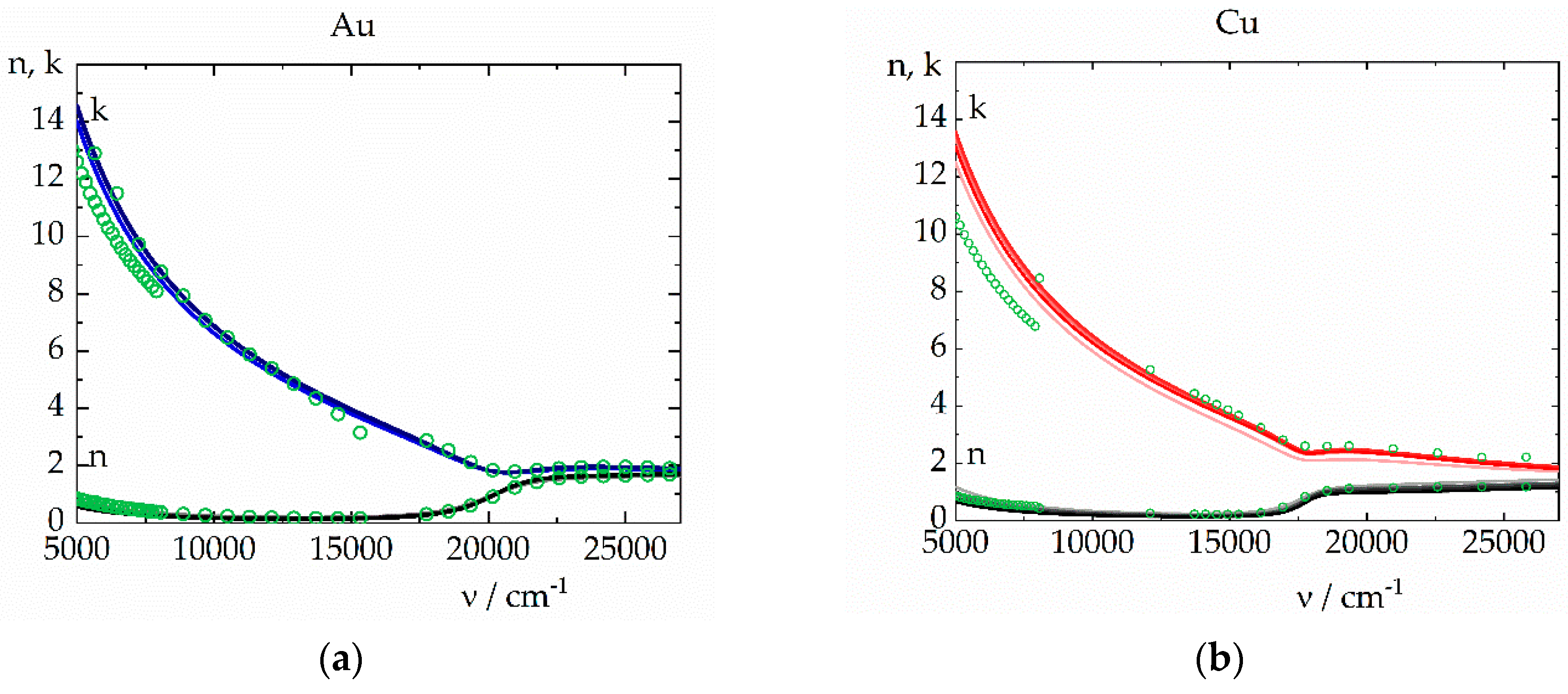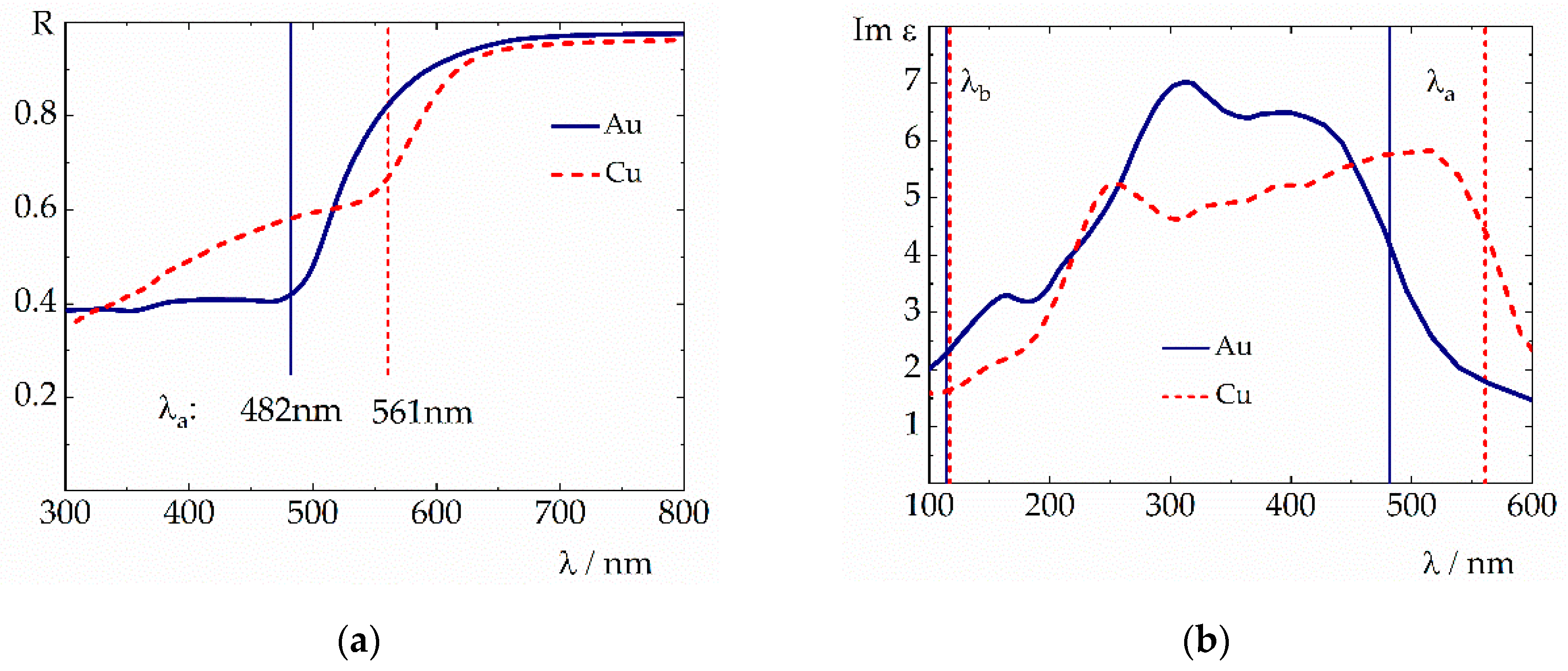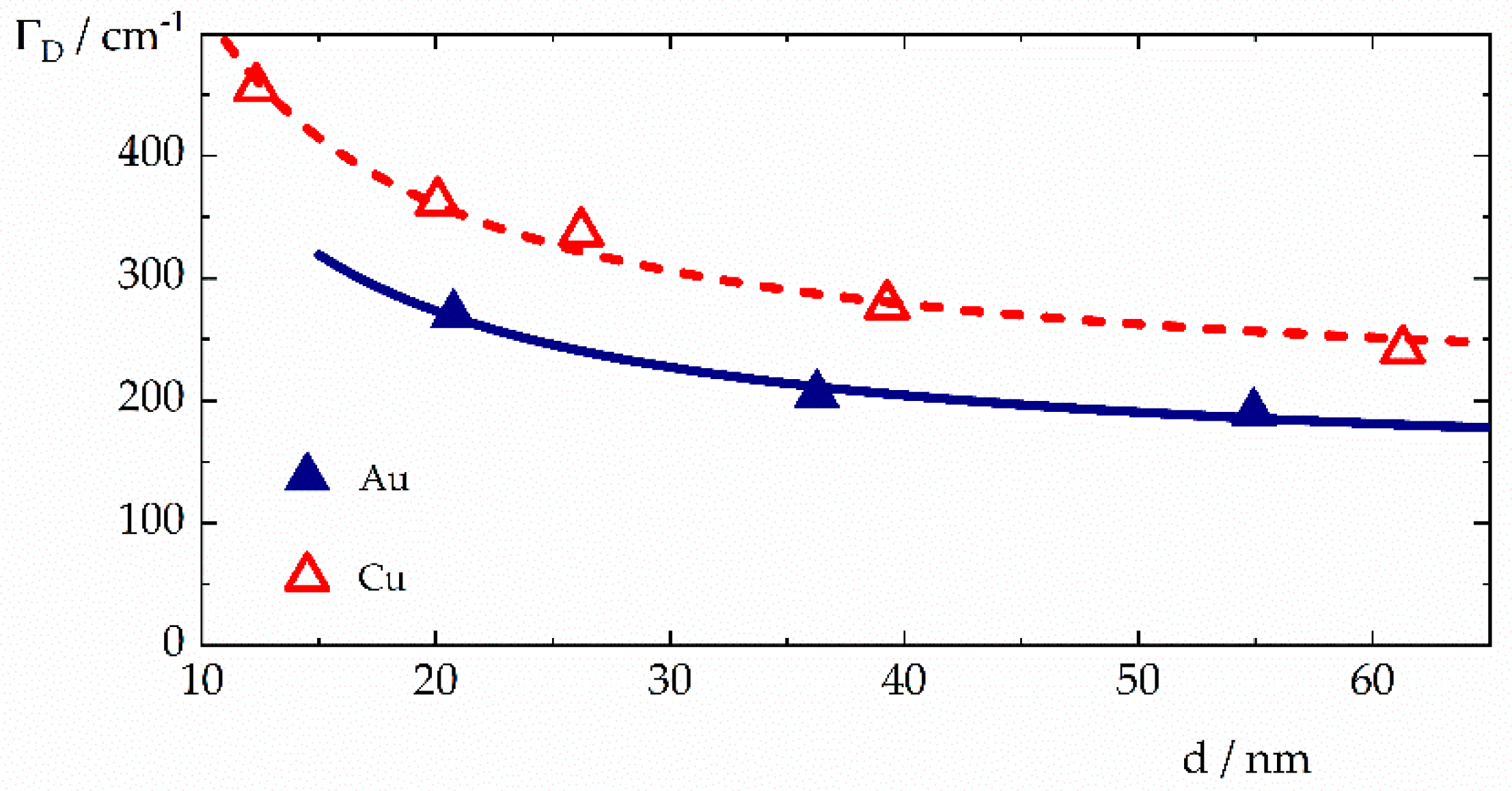Spectrophotometric Characterization of Thin Copper and Gold Films Prepared by Electron Beam Evaporation: Thickness Dependence of the Drude Damping Parameter
Abstract
:1. Introduction
2. Theory
2.1. Dispersion Model
2.2. Film Thickness Estimation
- Thicknesses have been determined from fitting experimental transmission and reflection spectra in terms of Equations (1), (2), and (6), taking the film thickness as a further fitting parameter.
- Thicknesses have been determined from X-ray reflection (XRR) analysis.
2.3. Mean Free Path Effects
3. Experimental
3.1. Layer Deposition
3.2. Layer Characterization
3.2.1. Spectrophotometry
3.2.2. X-ray Reflection XRR
3.2.3. Scanning Electron Microscopy SEM
4. Results
5. Discussion
- A thickness dependence that may obviously be described by means of the free path theory (Equation (11))
- A complicated microstructure of the film materials that results in . This is also clearly evident from the data from a previous study [26]
- The filling factor p ≤ 1;
- The constrictivity cr ≤ 1;
- The tortuosity tr ≥ 1.
6. Summary and Outlook
Author Contributions
Funding
Acknowledgments
Conflicts of Interest
References
- Born, M.; Wolf, E. Principles of Optics; Pergamon Press: Oxford, UK, 1968. [Google Scholar]
- Stenzel, O. The Physics of Thin Film Optical Spectra: An Introduction, 2nd ed.; Springer: Berlin, Germany, 2016; pp. 25–39. [Google Scholar]
- Jellison, G.E. Spectroscopic ellipsometry data analysis: Measured versus calculated quantities. Thin Solid Films 1998, 313, 33–39. [Google Scholar] [CrossRef]
- Ferlauto, A.S.; Ferreira, G.M.; Pearce, J.M.; Wronski, C.R.; Collins, R.W.; Deng, X.; Ganguly, G. Analytical model for the optical functions of amorphous semiconductors from the near-infrared to ultraviolet: Applications in thin film photovoltaics. J. Appl. Phys. 2002, 92, 2424–2436. [Google Scholar] [CrossRef]
- Brendel, R.; Bormann, D. An infrared dielectric function model for amorphous solids. J. Appl. Phys. 1992, 71, 1–6. [Google Scholar] [CrossRef]
- Orosco, J.; Coimbra, C.F.M. On a causal dispersion model for the optical properties of metals. Appl. Opt. 2018, 57, 5333–5347. [Google Scholar] [CrossRef]
- Wilbrandt, S.; Stenzel, O. Empirical extension to the multioscillator model: The beta-distributed oscillator model. Appl. Opt. 2017, 56, 9892–9899. [Google Scholar] [CrossRef]
- Macleod, H.A. Thin-Film Optical Filters, 4th ed.; CRC Press: Boca Raton, FL, USA, 2010. [Google Scholar]
- Gläser, H.J. Dünnfilmtechnologie auf Flachglas; Verlag Karl Hofmann: Schorndorf, Germany, 1999; pp. 164–248. [Google Scholar]
- Arndt, D.P.; Azzam, R.M.A.; Bennett, J.M.; Borgogno, J.P.; Carniglia, C.K.; Case, W.E.; Dobrowolski, J.A.; Gibson, U.J.; Hart, T.T.; Ho, F.C.; et al. Multiple determination of the optical constants of thin-film coating materials. Appl. Opt. 1984, 23, 3571–3596. [Google Scholar] [CrossRef] [PubMed] [Green Version]
- Anderson, J.C. Conduction in thin semiconductor films. Adv. Phys. 1970, 19, 311–338. [Google Scholar] [CrossRef]
- Weißmantel, C.; Hamann, C. Grundlagen der Festkörperphysik; Springer: Berlin, Germany, 1979; pp. 413–416. [Google Scholar]
- Kreibig, U. Optics of Nanosized metals. In Handbook of Optical Properties II: Optics of Small Particles, Interfaces, and Surfaces; Hummel, R.E., Wißmann, P., Eds.; CRC Press Inc.: Boca Raton, FL, USA, 1997; pp. 145–190. [Google Scholar]
- Gall, D. Electron mean free path in elemental metals. J. Appl. Phys. 2016, 119, 085101. [Google Scholar] [CrossRef] [Green Version]
- Cooper, B.R.; Ehrenreich, H.; Philipp, H.R. Optical properties of noble metals II. Phys. Rev. 1965, 138, A494–A507. [Google Scholar] [CrossRef]
- Ehrenreich, H.; Philipp, H.R. Optical properties of Ag and Cu. Phys. Rev. 1962, 128, 1622–1629. [Google Scholar] [CrossRef]
- Ordal, M.A.; Bell, R.J.; Alexander, R.W.; Long, L.L.; Querry, M.R. Optical properties of fourteen metals in the infrared and far infrared: Al, Co, Cu, Au, Fe, Pb, Mo, Ni, Pd, Pt, Ag, Ti, V., and W. Appl. Opt. 1985, 24, 4493–4499. [Google Scholar] [CrossRef] [PubMed]
- Zeman, E.J.; Schatz, G.C. An accurate electromagnetic theory study of surface enhancement factors for silver, gold, copper, lithium, sodium, aluminum, gallium, indium, zinc, and cadmium. J. Phys. Chem. 1987, 91, 634–643. [Google Scholar] [CrossRef]
- Grady, N.K.; Halas, N.J.; Nordlander, P. Influence of dielectric function properties on the optical response of plasmon resonant metallic nanoparticles. Chem. Phys. Lett. 2004, 399, 167–171. [Google Scholar] [CrossRef] [Green Version]
- Berciaud, S.; Cognet, L.; Tamarat, P.; Lounis, B. Observation of intrinsic size effects in the optical response of individual gold nanoparticles. Nano Lett. 2005, 5, 515–518. [Google Scholar] [CrossRef] [PubMed]
- Blaber, M.G.; Arnold, M.D.; Ford, M.J. Search for the ideal plasmonic nanoshell: The effects of surface scattering and alternatives to gold and silver. J. Phys. Chem. C 2009, 113, 3041–3045. [Google Scholar] [CrossRef]
- Stenzel, O.; Macleod, A. Metal-dielectric composite optical coatings: Underlying physics, main models, characterization, design and application aspects. Adv. Opt. Technol. 2012, 1, 463–481. [Google Scholar] [CrossRef]
- Stenzel, O. Optical Coatings: Material Aspects in Theory and Practice; Springer: Berlin, Germany, 2014; pp. 307–311. [Google Scholar]
- Palik, E.D. (Ed.) Handbook of Optical Constants of Solids; Academic Press: Orlando, FL, USA, 1998. [Google Scholar]
- Olmon, R.L.; Slovick, B.; Slovick, T.W.; Shelton, S.D.; Oh, S.-H.; Boreman, G.D.; Raschke, M.B. Optical dielectric function of gold. Phys. Rev. B 2012, 86, 235147. [Google Scholar] [CrossRef] [Green Version]
- Johnson, P.B.; Christy, R.W. Optical constants of the noble metals. Phys. Rev. B 1972, 6, 4370–4379. [Google Scholar] [CrossRef]
- Stenzel, O.; Pecho, O.; Holzer, L.; Neumann, M.; Schmidt, V. Predicting effective conductivities based on geometric microstructure characteristics. AIChE J. 2016, 62, 1834–1843. [Google Scholar] [CrossRef]
- Amotchkina, T.V.; Janicki, V.; Sancho-Parramon, J.; Tikhonravov, A.V.; Trubetskov, M.K.; Zorc, H. General approach to reliable characterization of thin metal films. Appl. Opt. 2011, 50, 1453–1464. [Google Scholar] [CrossRef] [PubMed]






| Metal | [14] | [14] | ρ/g cm−3 | [15] | (Equation (5)) | (Equation (3)) | νa0/cm−1 | |
|---|---|---|---|---|---|---|---|---|
| Cu | 36 | 39.9 | 8.92 | 9.3 [16] | 2.09 | 74 | 75,004 | 16,856 |
| Au | 27.3 | 37.7 | 19.32 | 8.83 [15] | 2.35 | 97 | 71,214 | 18,953 |
| Metal | Reference | ||
|---|---|---|---|
| Cu | [17] [18] | 59600 70660 | 36 385 |
| Au | [17] [18] [19] [20] [21] | 72800 71710 72200 72590 69000 | 112 285 279 282 74 |
| dQ1/nm | νa/cm–1 | νb/cm–1 | J/cm–1 | Γ/cm−1 | α = β | νp/cm–1 | ΓD/cm−1 | ||
|---|---|---|---|---|---|---|---|---|---|
| Fit | XRR | Equation (9) | |||||||
| 20.7 | 19.0 | 20.0 | 20,740 | 83,340 | 399,370 | 2010 | 0.85 | 71,530 | 270 |
| 36.3 | 34.8 | 34.0 | 20,730 | 86,610 | 439,750 | 1760 | 0.87 | 74,000 | 200 |
| 54.9 | 53.6 | 53.2 | 20,730 | 87,740 | 445,170 | 1720 | 0.87 | 74,260 | 190 |
| → | 0.0004 | 0.05 | 0.11 | 0.16 | 0.02 | 0.04 | 0.36 | ||
| dQ1/nm | νa/cm–1 | νb/cm–1 | J/cm–1 | Γ/cm−1 | α = β | νp/cm−1 | ΓD/cm−1 | ||
|---|---|---|---|---|---|---|---|---|---|
| Fit | XRR | Equation (9) | |||||||
| 12.3 | 10.3 | 11.8 | 17,770 | 81,870 | 312,610 | 1020 | 0.91 | 64,400 | 460 |
| 20.1 | 17.0 | 18.4 | 17,850 | 86,900 | 326,510 | 820 | 0.88 | 68,310 | 360 |
| 26.2 | 21.7 | 23.9 | 17,840 | 86,790 | 325,930 | 770 | 0.88 | 69,090 | 340 |
| 39.3 | 34.3 | 35.3 | 17,840 | 86,350 | 310,050 | 720 | 0.87 | 69,270 | 280 |
| 61.3 | 50.0 | 52.7 | 17,820 | 85,820 | 274,490 | 710 | 0.87 | 66,450 | 240 |
| → | 0.005 | 0.06 | 0.17 | 0.38 | 0.05 | 0.07 | 0.64 | ||
| dQ1/nm | νa/cm–1 | νb/cm–1 | J/cm–1 |
| 59 ± 7 | 17,800 ± 40 | 87,000 ± 15,000 | 330,000 ± 130,000 |
| Γ/cm–1 | α = β | νp/cm−1 | ΓD/cm−1 |
| 680 ± 40 | 0.89 ± 0.03 | 69,000 ± 7,000 | 250 ± 30 |
| Metal | [26] | δ/nm | (1 − pspec) | pspec | ||||||
|---|---|---|---|---|---|---|---|---|---|---|
| Cu | 36 | 74 | 197.4 | 13.5 | 6.9 | 39.9 | 15.0 | 16.5 | 0.55 | 0.45 |
| Au | 27.3 | 97 | 135.5 | 19.5 | 9.3 | 37.7 | 26.9 | 20.3 | 0.38 | 0.62 |
© 2019 by the authors. Licensee MDPI, Basel, Switzerland. This article is an open access article distributed under the terms and conditions of the Creative Commons Attribution (CC BY) license (http://creativecommons.org/licenses/by/4.0/).
Share and Cite
Stenzel, O.; Wilbrandt, S.; Stempfhuber, S.; Gäbler, D.; Wolleb, S.-J. Spectrophotometric Characterization of Thin Copper and Gold Films Prepared by Electron Beam Evaporation: Thickness Dependence of the Drude Damping Parameter. Coatings 2019, 9, 181. https://doi.org/10.3390/coatings9030181
Stenzel O, Wilbrandt S, Stempfhuber S, Gäbler D, Wolleb S-J. Spectrophotometric Characterization of Thin Copper and Gold Films Prepared by Electron Beam Evaporation: Thickness Dependence of the Drude Damping Parameter. Coatings. 2019; 9(3):181. https://doi.org/10.3390/coatings9030181
Chicago/Turabian StyleStenzel, Olaf, Steffen Wilbrandt, Sven Stempfhuber, Dieter Gäbler, and Sabrina-Jasmin Wolleb. 2019. "Spectrophotometric Characterization of Thin Copper and Gold Films Prepared by Electron Beam Evaporation: Thickness Dependence of the Drude Damping Parameter" Coatings 9, no. 3: 181. https://doi.org/10.3390/coatings9030181
APA StyleStenzel, O., Wilbrandt, S., Stempfhuber, S., Gäbler, D., & Wolleb, S.-J. (2019). Spectrophotometric Characterization of Thin Copper and Gold Films Prepared by Electron Beam Evaporation: Thickness Dependence of the Drude Damping Parameter. Coatings, 9(3), 181. https://doi.org/10.3390/coatings9030181




